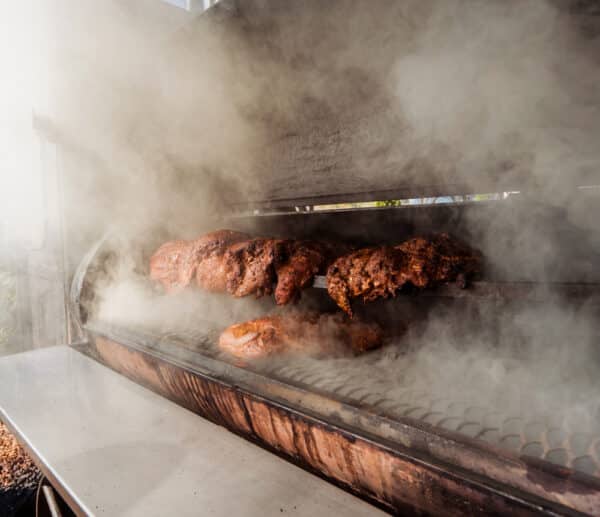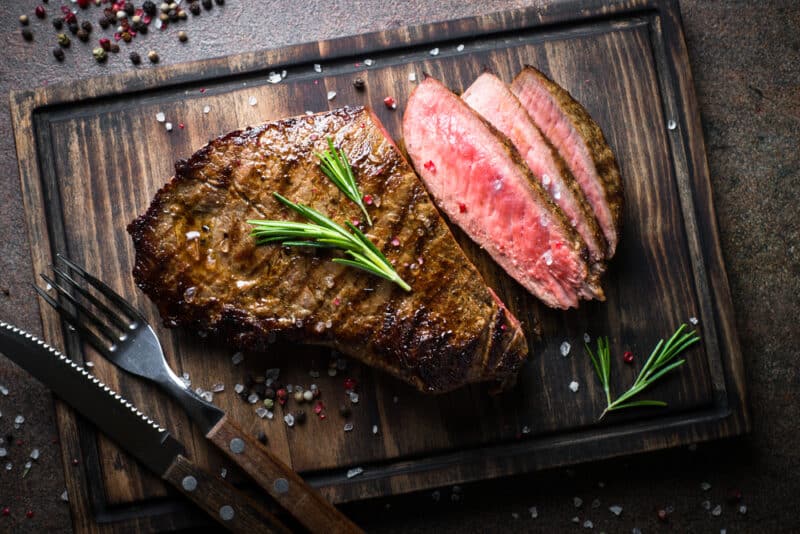Hot-and-Fast Brisket (Quick Cook Time Method)
TheGrillingMaster.com is reader-supported. If you buy something using the links on our site, we might earn an affiliate commission at no added cost to you. This helps us pay our staff to keep making awesome content for you!

Hot-and-fast brisket is your answer if you have ever wished there was a way to enjoy a melt-in-the-mouth brisket without having to wait for special occasions when you have 12 to 18 hours free.
The classic low-and-slow smoked brisket may always remain the favorite when you have friends and family to keep you company. However, with demanding lifestyles, those days have become few and far between.

If you question how it could be possible to produce that soft and delicious brisket you know and love in half the time, stand by.
This article will tell you how to do it. Then you can judge how close the result is to the classic low-and-slow prepared brisket.
Low-and-Slow vs. Hot-and-Fast Brisket
There are two different methods of cooking brisket—long-and-slow smoking and hot-and-fast smoking.
Long-and-slow smoking involves slow cooking at a low temperature of about 225-250°F. The process takes 12–18 hours or longer to break down the high content of tough collagen.
This method makes the meat really tender, like it’s melting in your mouth. The smoke from the wood chips, pellets, or chunks adds extra flavor and BBQ lovers typically prefer this method.
The hot and fast smoking of brisket is done at a high temperature (around 325-350°F). The cooking time is a lot shorter (4–6 hours).
This is often done when there’s not much time or if you want a crustier exterior. The end product may not be as tender as doing it low and slow, but it can still be flavorful.
The main differences between these two methods are time, temperature, and texture.
Brisket is a tough cut of meat, and low-and-slow gives you more tender beef brisket but takes longer. While hot-and-fast allows you to treat your family to a smoked brisket on a whim. The finished product may not be as tender. It’s for you to decide.
The hot-and-fast method’s higher heat breaks the collagen down faster. But it presents the pit master with other challenges.
Preparations for the Hot-and-Fast Brisket BBQ
The first step will be to get the smoker going. While the smoker heats up, you can trim and season the brisket. However, you may want to marinate the brisket overnight.
Preparing the Smoker
To make sure you get a perfectly smoked beef brisket, here’s what you should do: Clean out your smoker, add some wood chips or chunks (like hickory, cherry oak, or mesquite), and preheat the smoker to 300°F during the prep time of the brisket.

Trimming the Brisket
Beef brisket is a big ol’ hunk of meat that’s actually made up of two different cuts: the point and the flat. Both have great flavor, so it’s important to know how to trim them well.
It’s best to do this when the meat is cold. Start by trimming the fat. There are two kinds of fat too—one that renders down and adds flavor, and one that won’t render down and will block the smoke from getting into the meat.
Be sure the fat layer isn’t too thick, especially on the fatty side. Cut with a sharp knife to get rid of most of the thick, hard white fat between the point muscle and the flat.
Take away any extra silver skin off the bottom of the brisket, and lastly, cut off any dangling pieces of meat and fat. Those would just get charred if left on, so you want your food to taste delicious!

Separating the Whole Brisket
A whole brisket, also called a packer brisket, is made up of two different muscles: the flat, which is leaner and more likely to dry out, and the thicker point, which has lots of collagen and fat that makes it richer and juicier when cooked.
There is no rule that says you should separate the two parts, but keeping them together will take longer to cook through, so it’s a personal choice.
If you choose to split the flat from the point, do it before you start cooking, or before you let it rest. Some people really enjoy the fatty slices from the point, while others are big fans of the leaner slices from the flat.
When you get a really good brisket, like Wagyu, that fat of the point adds an amazing depth of flavor that adds to the natural flavor of the beef.
Follow this link to learn how to separate brisket point and flat.
Seasoning the Brisket for Hot-and-Fast Smoking

Try spicing up your brisket with your favorite rub or marinade. You could go with a store-bought spice rub or the classic Texas mix of salt and black pepper, with or without garlic powder.
Some BBQ masters make a rub of ground coffee beans and paprika or chili powder. For a sweeter option, try a mix of kosher salt and brown sugar, Worcestershire sauce, or onion powder.
Coat the entire surface of the brisket, but just make sure you don’t go too crazy with the brisket rub because you would rather not overpower the delicious smokey flavor.
Smoking Hot-and-Fast Brisket
Once the smoker is at a steady 300°F, put the brisket onto the cooking grate with the fatty side down.
- This will help keep the fat cap between the meat and the heat if you’re using a kettle smoker.
- Stick an internal thermometer into the thickest part of the meat to keep an eye on the brisket and smoker temperature.
- Put a disposable foil pan full of water in your smoker to catch fat drippings and stop flare-ups. The water also helps keep your brisket juicy.
- Shut the lid and let it cook for around an hour with the fat side facing down.
- Then flip it over to get some color on the other side. You want it to have a nice red color that will form the smoke ring, which means it’s time to wrap it.
- Smoke it until the thickest part of the brisket reads between 160 and 170°F.
- This usually takes around 3 hours, depending on the size of your brisket and the smoker you use.

Related Reading >> Brisket Spritzing (Spraying) vs. Mopping
Wrapping the Brisket
Once your brisket’s internal temp reaches 170°F, it will be in the stall, which means the temperature has reached a plateau. There are three ways of trapping the heat and moisture to deal with the stall:
- Trap the heat by wrapping the brisket tightly in heavy-duty aluminum foil or butcher’s wrap.
- Place the brisket in a disposable aluminum roasting pan, mop it with a BBQ sauce or your choice of basting sauce, and cover the pan with heavy-duty aluminum foil.
- Boat the brisket by placing it onto two layers of aluminum foil with the fat cap exposed. Then crinkle the foil on the sides to create a boat, leaving the bottom and edges covered.
The Final Stretch of Your Hot-and-Fast Brisket
Place your boated or wrapped brisket back on your smoker to continue cooking.
After a couple of hours, the internal temperature should reach 200°F to 208°F, which indicates it is at maximum tenderness. If the temperature probe goes into the meat as easily as if it is soft butter, you’ll know it is time to rest the brisket.

Resting the Brisket
Once your brisket is done in the smoker, take it out, keep it wrapped, or wrap it now in foil or butcher paper, then put it in a towel and put it in a clean, dry cooler. Let it rest for an hour or two, this will keep it juicy and tender.
Slicing the Brisket
It’s always good to cut beef against the grain to make it tender. If you didn’t separate the two pieces of the brisket before smoking it, do that now, since the grain of the meat is different on each side. Then, you can slice the flat into thin pieces and make burnt ends out of the point for something different.

Bottom Line
In conclusion, smoking a brisket hot and fast is a great way to enjoy a delicious smoked brisket without having to wait all day for it to cook. You can use any of your low and slow brisket recipes and adjust the temperatures to the higher temps for hot and fast brisket.
It’s a great option for those who don’t have the patience or the time to smoke a brisket low and slow. It also yields a tender, juicy and flavorful brisket that will have everyone coming back for seconds.
So, if you’re looking for a quick and easy way to enjoy a delicious brisket, try smoking it hot and fast!
Frequently Asked Questions
Q: At what temperature should I cook hot-and-fast brisket?
A: Typically, hot and fast brisket is cooked at a temperature between 300-350°F
Q: What is the total time to cook a hot-and-fast brisket?
A: The cooking time for hot and fast brisket can vary depending on the size of the brisket and the temperature of your grill or smoker. Generally, the brisket cooks for 4 to 6 hours.
Keep in mind that different smokers like Weber pellet grills, pellet smokers, kettle grills, etc., and brisket sizes can affect the cooking time. To make sure it’s cooked right, use a quick-read thermometer to check the internal temp.
Q: What type of wood should I use for hot and fast brisket?
A: Any type of wood can be used for hot and fast brisket, but fruit woods like apple or cherry are popular choices as they provide a milder smoke flavor.
Q: Do I still need to wrap the brisket when cooking hot and fast?
A: Yes, wrapping the brisket in foil or butcher paper is still recommended when cooking hot and fast. This helps to keep the meat moist and tender.
Q: How do I know when the brisket is done?
A: The best way to know when your brisket is done is by checking the internal temperature with a meat thermometer. The ideal temperature range for brisket is between 195-205°F. You can also check for tenderness by probing the meat with a fork or a toothpick – it should feel tender and easily pulled apart.
Q: Do I have to separate the flat and point of the brisket?
A: It is generally recommended to separate the point and flat when smoking a brisket for the best results. The brisket flat and point are two different muscles that make up the brisket, and they have different cooking times and temperatures. The point is a thicker, fattier section that takes longer to cook, while the flat is a leaner, thinner section that cooks faster.
Q: Do I have to let the brisket rest?
A: Giving your brisket some time to chill out helps it to soak up all its own juice, meaning it’ll be a nice and juicy brisket rather than tough and dry. It also makes it easier to slice and the flavor of your rub will be even more intense in every bite!
Q: Should I smoke brisket fat side down or fat side up?
A: For the quick-cooking process at higher temperatures, start with the fat side down. This will help the fat render and protect the meat from the heat.
Q: How do I know what size brisket to buy?
A: Work on a 1/2 pound serving size per person. However, you should calculate one pound per person, which will account for the weight lost through trimming, fat rendering, and loss of liquid.
Q: How should I store leftover smoked brisket?
A: Store the leftover BBQ brisket in 1 or 1 1/2-pound pieces, vacuum-packed or wrapped in a double layer of plastic and aluminum foil. You can store it for 4 to 5 days in the refrigerator, or up to 3 months in the freezer. Be sure to mark the contents and date on a label.
Learn More About Grilling
If you want to learn more about grilling, check out these other helpful resources!

Kevin Turner
Hi there, I'm Kevin Turner, Founder and CEO of thegrillingmaster.com. I started this website to share my passion and knowledge with you. You can leverage my years of experience as a pit master and professional to grill great food!
About The Grilling Master
Hi there, I'm Kevin Turner, Founder and CEO of thegrillingmaster.com.
My passion has always been grilling, smoking and BBQ delicious meats that satisfy my inner carnivore!
I started this website to share my passion and knowledge with you, the hungry reader who wants to prepare the perfect meal.
You can leverage my years of experience as a pit master and professional.
Send me a message and let's connect on Twitter here.

















